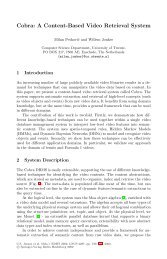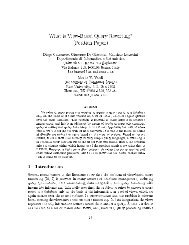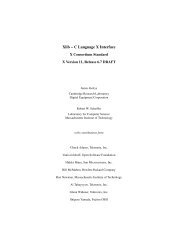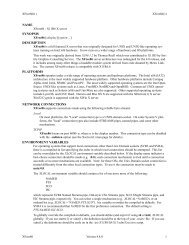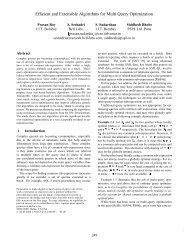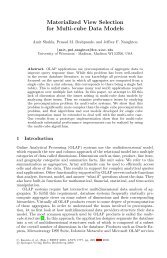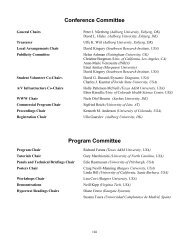Extracting Sentence Segments for Text Summarization: A Machine ...
Extracting Sentence Segments for Text Summarization: A Machine ...
Extracting Sentence Segments for Text Summarization: A Machine ...
You also want an ePaper? Increase the reach of your titles
YUMPU automatically turns print PDFs into web optimized ePapers that Google loves.
Abstract<br />
<strong>Extracting</strong> <strong>Sentence</strong> <strong>Segments</strong> <strong>for</strong> <strong>Text</strong><br />
<strong>Summarization</strong>: A <strong>Machine</strong> Learning Approach<br />
Wesley T. Chuang 1,2 and Jihoon Yang 2<br />
1Computer Science Department, UCLA, Los Angeles, CA 90095, USA<br />
yelsewOcs, ucla. edu<br />
2HRL Laboratories, LLC, 3011 Malibu Canyon Road, Malibu, CA 90265, USA<br />
{yelsewlyang}©wins. hrl. com<br />
With the proliferation of the Internet and the huge<br />
amount of data it transfers, text summarization is be-<br />
coming more important. We present an approach to<br />
the design of an automatic text summarizer that gen-<br />
erates a summary by extracting sentence segments.<br />
First, sentences are broken into segments by special<br />
cue markers. Each segment is represented by a set<br />
of predefined features (e.g. location of the segment,<br />
average term frequencies of the words occurring in<br />
the segment, number of title words in the segment,<br />
and the like). Then a supervised learning algorithm<br />
is used to train the summarizer to extract important<br />
sentence segments, based on the feature vector. Re-<br />
sults of experiments on U.S. patents indicate that the<br />
per<strong>for</strong>mance of the proposed approach compares very<br />
favorably with other approaches (including Microsoft<br />
Word summarizer) in terms of precision, recall, and<br />
classification accuracy.<br />
Keywords: text summarization, machine learning,<br />
sentence segment extraction<br />
1 Introduction<br />
With tons of in<strong>for</strong>mation pouring in every day, text<br />
summaries are becoming essential. Instead of having<br />
to go through an entire text, people can understand<br />
a text quickly and easily by means of a concise sum-<br />
mary. The title, abstract and key words, if provided,<br />
can convey the main ideas, but they are not always<br />
present in a document. Furthermore, they may not<br />
touch on the in<strong>for</strong>mation that users need to know.<br />
Permission to make digital or herd copies of all or part of this work <strong>for</strong><br />
personal or classroom use is granted without fee provided that<br />
copies are not made or distributed <strong>for</strong> profit or commercial advan-<br />
tage and that copies bear this notice end the full citation on the first page<br />
To copy otherwise, to republish, to post on servers or to<br />
redistribute to hers, requires prior specific permission and/or e fee.<br />
SIGIR 2000 7/00 Athens, Greece<br />
© 2000 ACM 1-58113-226-3/00/0007..,$5.00<br />
152<br />
In order to obtain a good summary automatically,<br />
we are faced with several challenges. The first chal-<br />
lenge is the extent to which we must "understand"<br />
the chosen text. It is very difficult to understand a<br />
document without digesting the whole text. How-<br />
ever, detailed parsing takes a considerable amount of<br />
time, and does not necessarily guarantee a good sum-<br />
mary. In our approach we do not claim to generate a<br />
summary by abstract (after understanding the whole<br />
text), but rather, by extract (meaning we attempt to<br />
extract key segments out of the text). This summa-<br />
rization by extract will be good enough <strong>for</strong> a reader<br />
to understand the main idea of a document, though<br />
the quality (and understandability) might not be as<br />
good as a summary by abstract.<br />
The second challenge relates to program design. A<br />
summary may be more or less skewed subjectively<br />
depending on which features or characteristics are<br />
used to generate it - occurrence of title words in sen-<br />
tences, key words in headings, etc. Moreover, some<br />
features will give stronger indications of general use-<br />
fulness than others. In short, features all have a de-<br />
gree of subjectivity and a degree of generality when<br />
they are used to extract a summary by identifying<br />
key sentences and fragments, and ideally, we are look-<br />
ing <strong>for</strong> those selection features that are independent<br />
of the types of text and user. These features will<br />
be used to distinguish the important parts from the<br />
less essential parts of the text and to generate a good<br />
summary.<br />
Against this background, we propose an approach<br />
to automatic text summarization by sentence seg-<br />
ment extraction using machine learning algorithms.<br />
We per<strong>for</strong>m a "shallow parsing" [6] by looking at spe-<br />
cial markers in order to determine the sentence seg-<br />
ments. Special markers and their associated signifi-<br />
cance, rhetorical relations, discriminate one portion<br />
of text from another. We define a set of features (e.g.<br />
average term frequency, rhetorical relations, etc.) <strong>for</strong><br />
each sentence segment. Then we convert these fea-<br />
tures into a vector representation and apply machine
learning algorithms in order to derive the rules or<br />
conditions by which we will generate a summary. Re-<br />
gardless of whether the features have a high degree of<br />
subjectivity or generality, they all have a role to play<br />
in indicating which sentence segments in the text are<br />
more likely to be chosen as summary material. For<br />
example, features that are used in classical summa-<br />
rization methods [4, 1] such as title words, location,<br />
term frequency, etc., bear high contingency <strong>for</strong> selec-<br />
tion. Features that come from Rhetorical Structure<br />
Theory [5] such as antithesis, cause, circumstances,<br />
concession, etc., will also determine the significance<br />
of a sentence segment. As we shall find out, machine<br />
learning will report to us whether one feature is use-<br />
ful at all in looking <strong>for</strong> summary material based on<br />
achieving a good balance between subjectivity and<br />
generality of summarization.<br />
The rest of this paper is organized as follows: Sec-<br />
tion 2 presents some of the previous work in text<br />
summarization from which we developed our ideas.<br />
Section 3 describes our approach to text summariza-<br />
tion based on sentence segment extraction. Section 4<br />
presents the results of experiments designed to evalu-<br />
ate the per<strong>for</strong>mance of our approach. Section 5 con-<br />
cludes with a summary and discussion of some direc-<br />
tions <strong>for</strong> future research.<br />
2 Related Work<br />
Luhn [4] and Edmundson [1] proposed a simple ap-<br />
proach to automatic text summarization. They con-<br />
sidered features such as average term frequency, ti-<br />
tle words, sentence location, and bonus/stigma words<br />
in order to extract sentences to make a summary.<br />
Their approaches per<strong>for</strong>med fairly well despite their<br />
simplicity, and have been the basis in the area of<br />
automatic text summarization. However, their ap-<br />
proaches ignored the structural aspect of the text<br />
which may contain significant in<strong>for</strong>mation <strong>for</strong> sum-<br />
marization.<br />
As an attempt to exploit the structural aspect of<br />
text, Marcu [6] provided a corpus analysis when he<br />
created a tree, known as the Rhetorical Structure<br />
Theory (RST) Tree, <strong>for</strong> all the segments in the text.<br />
After the tree is created <strong>for</strong> each document, segments<br />
are laid out in a manner in which more important<br />
segments occupy the upper level of the tree nodes,<br />
whereas less important segments reside deeper in the<br />
tree. As a result, summarization can be carried out<br />
by per<strong>for</strong>ming cuts at various depths of the tree, pro-<br />
ducing summaries of various lengths. His approach,<br />
however, suffers from the complexity issue. Every<br />
time a new document needs to be considered, the pro-<br />
cess <strong>for</strong> constructing its RST tree is very costly, not<br />
to mention the scalability factor <strong>for</strong> large amounts of<br />
data. Furthermore, when the text does not contain<br />
many rhetorical relations, there is little telling which<br />
segment is more important than the others.<br />
There is another group of researchers who gener-<br />
ated a summary by sentence extraction using the<br />
a<strong>for</strong>ementioned non-structured features (e.g. title<br />
words) [3, 11]. Their significant contribution is that<br />
they made use of machine learning algorithms to de-<br />
termine the sentences to be extracted. However, since<br />
a sentence is the basic unit of their consideration, the<br />
resulting summary may still be unnecessarily long. In<br />
addition, there is a lack of the features based on the<br />
structural aspects (e.g. rhetorical relations) of sen-<br />
tences.<br />
Our approach combines aspects of all the previ-<br />
ous work mentioned above. We generate a summary<br />
by extracting sentence segments to make the sum-<br />
mary concise. And we represent each sentence seg-<br />
ment which is determined based on cue phrases, by<br />
using a set of non-structured as well as structured fea-<br />
tures, to both of which machine learning algorithms<br />
are applied in order to derive rules <strong>for</strong> summarization.<br />
3 Design of a <strong>Text</strong> Summarizer<br />
Based on <strong>Sentence</strong> Segment<br />
Extraction<br />
There are three steps in the design of our system:<br />
segmentation of sentences, feature representation of<br />
segments, and training of the summarizer.<br />
3.1 <strong>Sentence</strong> Segmentation<br />
Our segmentation method is basically the same as<br />
Marcu's [6]. A sentence is segmented by a cue phrase.<br />
(See [6] <strong>for</strong> detailed descriptions of the cue phrases<br />
and the segmentation algorithm.) The basic idea be-<br />
hind this is to separate out units (i.e. sentence seg-<br />
ments) that possibly convey independent meanings.<br />
For instance, we can generate two sentence segments<br />
"I love playing tennis" and "because it is exciting"<br />
from the topic sentence "I love playing tennis because<br />
it is exciting". The cue phrase used here is because<br />
which connects the two segments (i.e. main and sub-<br />
ordinate clauses) with a cause relationship. The pur-<br />
pose of segmentation is to use sentence segments as a<br />
basic unit <strong>for</strong> summarization. The complexity of the<br />
segmentation process is O(n), where n is the number<br />
of sentences.<br />
Figure 1 shows the segmentation of a sample patent<br />
data source taken from the U.S. Patent and Trade-<br />
153
mark Office [8]. <strong>Segments</strong> are bounded by the bracket<br />
"]" with an integer (segment ID) numbering their<br />
sequences. Words enclosed by curly braces "}" are<br />
called comma parenthesis [6], which are considered<br />
as additional in<strong>for</strong>mation inside a segment, and will<br />
be thrown out during summarization.<br />
[ This invention relates in general to database management<br />
systems per<strong>for</strong>med by computers, and in particular, to a<br />
method and apparatus <strong>for</strong> accessing a relational database over<br />
the Internet using macro language files. 1]<br />
[ With the fast growing popularity of the Internet and the<br />
World Wide Web { ( also known as " WWW " or the " Web " ) },<br />
2] [ there is also a fast growing demand <strong>for</strong> Web access to<br />
databases. 3] [ However, it is especially difficult to use<br />
relational database management system { ( RDBMS ) } softuare<br />
with the Web. 4] [ One of the problems with using RDBMS<br />
software on the Web is the lack of correspondence between the<br />
protocols used to communicate in the Web with the protocols<br />
used to communicate with RDBMS software. 5]<br />
[ For example, the Web operates using the Hyper<strong>Text</strong><br />
Transfer Protocol { ( HTTP ) } and the Nyper<strong>Text</strong> Markup<br />
Language { ( HTML ) }. 6] [ This protocol and language<br />
results in the communication and display of graphical<br />
in<strong>for</strong>mation that incorporates hyperlinks. 7] [ Nyperlinks are<br />
network addresses that are embedded in a word, phrase, icon<br />
or picture that are activated 8] [ when the user selects a<br />
highlighted item displayed in the graphical in<strong>for</strong>mation. 9]<br />
[ HTTP is the protocol used by Web clients and Web servers to<br />
communicate between themselves using these hyperlinks. I0] [<br />
HTML is the language used by Web servers to create and<br />
connect together documents that contain these hyperlinks. 11]<br />
[ In contrast, most RDBMS software uses a Structured Query<br />
Language { ( SQL ) } interface. 12] [ The SQL interface has<br />
evolved into a standard language <strong>for</strong> RDBMS software and has<br />
been adopted as such by both the American Nationals Standard<br />
Organization { ( ANSI ) } and the International Standards<br />
Organization { ( IS0 ) }. 13]<br />
[ Thus, there is a need in the art <strong>for</strong> methods of<br />
accessing RDBM$ software across the Internet network, and<br />
especially via the World Wide Web. 14] [ Further, there is a<br />
need <strong>for</strong> simplified development environments <strong>for</strong> such<br />
systems. 15]<br />
[ To overcome the limitations in the prior art described<br />
above, and to overcome other limitations that will become<br />
apparent upon reading and ~nderstanding the present<br />
specification, 16] [ the present invention discloses a<br />
method and apparatus <strong>for</strong> executing SQL queries in a<br />
relational database management system via the Interuet. 17]<br />
[ In accordance with the present invention, Web users can<br />
request in<strong>for</strong>mation from RDBMS software via HTML input <strong>for</strong>ms,<br />
which request is then used to create an SGL statement <strong>for</strong><br />
execution by the RDBMS software. 18] [ The results output by<br />
the RDBMS software are themselves trans<strong>for</strong>med into HTML<br />
<strong>for</strong>mat <strong>for</strong> presentation to the Web user. 19]<br />
Figure 1: A patent data source and its segmentation<br />
3.2 Feature Representation<br />
The sentence segments need to be represented by a<br />
set of features. As described be<strong>for</strong>e, there are two<br />
kinds of features we consider: structured and non-<br />
structured. The <strong>for</strong>mer are related to the structure<br />
of the text (e.g. rhetorical relations), while the latter<br />
are not (e.g. title words).<br />
154<br />
3.2.1 Rhetorical Relations<br />
Mann and Thompson noted in their Rhetorical Struc-<br />
ture Theory that a sentence can be decomposed into<br />
segments, usually clauses [5]. In a complex sentence,<br />
with two clauses, the main segment is called a nu-<br />
cleus, and its subordinate segment is called a satellite<br />
and is connected to the main segment by some kind<br />
of rhetorical relation. Figure 2 illustrates two exam-<br />
ples of rhetorical relations. There are many such sig-<br />
naled by different cue phrases (e.g. because, but, if,<br />
however, ...). Generally, when a rhetorical relation<br />
occurs, the nucleus is considered as a more impor-<br />
tant segment - and has more chance of being in the<br />
summary - than its satellite counterpart.<br />
Using Marcu's discourse-marker-based hypothesiz-<br />
ing algorithm [6], we discover rhetorical relations on<br />
the base level of segments. In other words, we ob-<br />
tain the rhetorical relations of a segment to another<br />
segment in a nearby region instead of taking all the<br />
combinations of segments recursively to generate the<br />
whole RST tree - a computation which is significantly<br />
expensive. The complexity <strong>for</strong> finding such base-level<br />
rhetorical relations is O(n2), where n is the number<br />
of sentences.<br />
A rhetorical relation r(name, satellite, nucleus)<br />
shows that there exists a relation (whose type is name)<br />
between the satellite and nucleus segments. The<br />
hypothesizing algorithm finds rhetorical relations <strong>for</strong><br />
all the segments in the following <strong>for</strong>m:<br />
n k,<br />
i=1 3=1<br />
= (rll • r12 ~.--rlkl)N (r21 • r22 (]~...r2k2)<br />
n... n (r., e... r.k.)<br />
where ki is the maximum distance to the salient unit<br />
as defined in [6]. Figure 3 shows the rhetorical rela-<br />
tions produced <strong>for</strong> the patent data in Figure 1.<br />
3.2.2 Feature Vector<br />
We collect a total of 23 features and generate the<br />
feature vector:<br />
P =< A,f2,f3,14,'",A2,123 ><br />
They (fl,-",//23) are to indicate the features <strong>for</strong> ev-<br />
ery segment we obtain in the sentence segmentation<br />
process. Though all the features in the vector will<br />
be taken into consideration together in classification<br />
(of segments to be included in the summary), we di-<br />
vide the features into the following three groups <strong>for</strong><br />
analysis:
[2] With the fast growing populatiry of<br />
the Internet and the World Wide Web<br />
[3] there is also a fast growing demand <strong>for</strong><br />
Web access to databases.<br />
[8] Hyperlinks are network addresses that are imbedded<br />
in a word, phrase, icon or picture that are activated<br />
m<br />
[9] when the user selects a highlighted item display ] [<br />
in the graphical in<strong>for</strong>mation,<br />
HRR =<br />
JUSTIFICATIONS<br />
[[With ... 211 l[ ...<br />
satellite nucleus<br />
• ..<br />
~////~- - ~ONDITION<br />
nucleus satellite<br />
Figure 2: <strong>Sentence</strong> segments and their rhetorical relations<br />
(r(JUSTIFICATION, 2, 3) @ r(JUSTIFICATION, 1, 3))n<br />
(r(ANTITHESIS, 4, 3) • r(ANTITHESIS, 5, 3) • r(ANTITHESIS, 6, 3)0<br />
r(ANTITHESIS, 4, 2) • r(ANTITHESIS, 5, 2) • r(ANTITHESIS, 6, 2))n<br />
(r(EXAMPLE, 6, 5) • r(EXAMPLE, 7, 5) • r(EXAMPLE, 8, 5)<br />
Or(EXAMPLE, 6, 4) • r(EXAMPLE, 7, 4) • r(EXAMPLE, 8, 4))n<br />
r(CONDITION, 9, 8)n<br />
(r(JUSTIFICATION, 13, 14) • r(JUSTIFICATION, 13, 15)O<br />
r(JUSTIFICATION, 12, 14) • r(JUSTIFICATION, 12, 15))n<br />
(r(PURPOSE, 16, 17) • r(PURPOSE, 16, 18))n<br />
(r(ELABORATION, 11, 10) • r(JOINT, 10, 12) • r(JOINT, 9, 11)O<br />
r(JOINT, 9, 12) • r(ELABORATION, 11,8) @ r(JOINT, 8, 12)<br />
Or(ELABORATION, 11, 7) • r(ELABORATION, 12, 7))<br />
Figure 3: Rhetorical relations <strong>for</strong> the sample patent data<br />
• Group I: 1. paragraph number, 2. offset in the<br />
paragraph, 3. number of bonus words, 4. num-<br />
ber of title words, 5. average term frequency<br />
• Group II: 6. antithesis, 7. cause, 8. circum-<br />
stances, 9. concession, 10. condition, 11. con-<br />
trast, 12. detail, 13. elaboration, 14. example,<br />
15. justification, 16. means, 17. otherwise, 18.<br />
purpose, 19. reason, 20. summary relation<br />
• Group III: 21. weight of nucleus, 22. weight of<br />
satellite, 23. max level.<br />
Features 1-5 in Group I are non-structural at-<br />
tributes of the text. They are counters associated<br />
with the location of the segment, number of signif-<br />
icant (bonus) words (out of the pre-defined set of<br />
46 words) in the segment, and the average term fre-<br />
quency of the words in the segment.<br />
Features 6-20 are distinct rhetorical relations. The<br />
features corresponding to the relations are initialized<br />
to O's. When a segment is hypothesized with a rela-<br />
tion, feature F~ <strong>for</strong> the relation will change its value<br />
by the following equation:<br />
F, = { F~ + 1.O/x if nucleus<br />
F, - 1.O/x if satellite<br />
911<br />
where x is the number of the asymmetric, exclusive-<br />
or relations being hypothesized with the segment. F,<br />
shows how strong (in terms of its role as nuclei or<br />
satellites) the feature (relation) is <strong>for</strong> the correspond-<br />
ing segment.<br />
Features 21-23 in the last group are collective de-<br />
scriptions of the rhetorical relations. For example,<br />
weight of nucleus (satellite) sums up all the<br />
occurrences in which a segment acts as a nucleus<br />
(satellite), regardless of which relation it possesses.<br />
Max level describes how many times, recursively, a<br />
segment can be a satellite of another satellite. The<br />
following semi-naive algorithm (see Figure 4) depicts<br />
how max level is determined. The algorithm has<br />
a complexity of O(n2), where n is the total number<br />
of relations. It is a simpler alternative in place of<br />
Marcu's complicated, expensive RST tree generation<br />
algorithm.<br />
155
Input: Hypothesized rhetorical relations HRR<br />
Output: The max level of each segment<br />
//initialize the set of relation chains<br />
RelationChain RC := null;<br />
//get asymmetric relations from HRR<br />
AsymmetricRhetoricalRelation ARR<br />
:= asymmeticRelation (HRR);<br />
//compute relation chains by checking all terms in<br />
all relations<br />
<strong>for</strong> i := 1 to length(ARR)<br />
Ri := ARR(i);<br />
<strong>for</strong> j := 1 to length(R/)<br />
r, 3 = Ri(j);<br />
<strong>for</strong> k := 1 (k!=i) to length(ARR)<br />
Rk := ARR(k);<br />
<strong>for</strong> 1 := 1 to length(Rk)<br />
rkt = Rk(1);<br />
if (r, 3 .nucleus == rkl .satellite)<br />
RC := RC L) concatenate(r~j, rkl);<br />
else if (r~j.satellite == rkt.nucleus)<br />
RC := RC U concatenate(rm, r~a);<br />
// check the length of relation chains<br />
countLevels(RC);<br />
Figure 4: Algorithm <strong>for</strong> finding the max level of a<br />
satellite<br />
3.3 Summarizer Training<br />
Here the goal is to select a few segments as a sum-<br />
mary that can represent the original text. With the<br />
feature vectors generated in previous steps, we can<br />
easily apply machine learning algorithms to train a<br />
summarizer (i.e. supervised learning). We are inter-<br />
ested in seeing whether programs can quickly learn<br />
from our model summary and categorize which seg-<br />
ments should be in the target summary and which<br />
should not. We want them to learn this <strong>for</strong> all 23<br />
a<strong>for</strong>ementioned features that are deemed representa-<br />
tive.<br />
A variety of machine learning algorithms have<br />
been proposed in the literature [7, 12]. We chose<br />
the decision tree algorithm (C4.5) [9, 10], the naive<br />
Bayesian classifier (Bayesian) [7], and the inter-<br />
pattern distance-based constructive neural network<br />
learning algorithm (DistAl) [12] <strong>for</strong> our experiments.<br />
3.3.1 Decision Trees<br />
Decision tree algorithms [9, 10] are one of the most<br />
widely used inductive learning methods. Among the<br />
various decision tree learning algorithms, we chose<br />
the C4.5 algorithm [10] to train the summarizer. A<br />
decision tree is generated by finding a feature that<br />
yields the maximum in<strong>for</strong>mation gain. A node is<br />
then generated with a set of rules corresponding to<br />
the feature. This process is repeated <strong>for</strong> other fea-<br />
tures in succession until no further in<strong>for</strong>mation gain<br />
is obtainable. In testing, a pattern is repeatedly com-<br />
pared with a node of a decision tree starting from the<br />
root and following appropriate branches based on the<br />
condition and feature value until a terminal node is<br />
reached. The pattern is then presumed to belong to<br />
the class the terminal node represents. C4.5 has been<br />
known to be a very fast and efficient algorithm with<br />
good generalization capability. (See [7] <strong>for</strong> detailed<br />
descriptions of the algorithm and examples.)<br />
3.3.2 Naive Bayesian Classifier<br />
We apply the naive Bayesian classifier as used in [3]:<br />
P(c E C I F1,F2,...Fk)<br />
Hjk=ip(Fj I c • c)P(c • c)<br />
H~=i P(f,)<br />
where C is the set of target classes (i.e. in the sum-<br />
mary or not in the summary) and F is the set of fea-<br />
tures. That is, we are trying to find a class C that will<br />
have the highest probability of observing F. In our<br />
experiment, since the values of most of the features<br />
are real numbers, we assume a normal distribution <strong>for</strong><br />
every feature, and use the normal distribution density<br />
function to calculate the probability P(F3). That is,<br />
1 - 2<br />
P( ) = j ,/g e<br />
where #j and ~j are mean and standard deviation <strong>for</strong><br />
feature F3, respectively.<br />
156<br />
3.3.3 DistAl<br />
DistAl [12] is a simple and relatively fast constructive<br />
neural network learning algorithm <strong>for</strong> pattern classi-<br />
fication. (A constructive learning algorithm builds a<br />
network dynamically by adding neurons as necessary<br />
(e.g. to obtain better classification accuracy) instead<br />
of using a fixed network architecture determined a<br />
priori. See [2] <strong>for</strong> general in<strong>for</strong>mation on constructive<br />
learning.) The key idea behind DistAl is to add hy-<br />
perspherical hidden neurons one at a time based on a
greedy strategy which ensures that each hidden neu-<br />
ron that is added correctly classifies a maximal subset<br />
of training patterns belonging to a single class. Cor-<br />
rectly classified examples can then be eliminated from<br />
further consideration. The process is repeated until<br />
the network correctly classifies the entire training set.<br />
When this happens, the training set becomes linearly<br />
separable in the trans<strong>for</strong>med space defined by the hid-<br />
den neurons. In fact, it is possible to set the weights<br />
on the hidden-to-output neuron connections without<br />
going through an iterative, time-consuming process.<br />
It is straight<strong>for</strong>ward to show that DistAl is guaran-<br />
teed to converge to 100% classification accuracy on<br />
any finite training set in time that is polynomial in<br />
the number of training patterns. Moreover, experi-<br />
ments reported in [12] show that DistAl, despite its<br />
simplicity, yields classifiers that compare quite favor-<br />
ably with those generated using more sophisticated<br />
(and substantially more computationally demanding)<br />
learning algorithms.<br />
4 Experiments<br />
In our experiments, first, we used the three learn-<br />
ing algorithms (C4.5, Bayesian, DistAl) and evaluated<br />
their per<strong>for</strong>mance. Next, we compared this to the<br />
per<strong>for</strong>mance of the summarizer in Microsoft Word,<br />
since it is one of the most popular softwares being<br />
used nowadays.<br />
Finally, we compared both of these with the per-<br />
<strong>for</strong>mance of a very simple heuristic based on pre-<br />
determined weights <strong>for</strong> several features introduced<br />
be<strong>for</strong>e. These weights we used to assign each seg-<br />
ment a score and to generate a summary containing<br />
only segments that had high scores. The score <strong>for</strong><br />
each segment was based on this function:<br />
Score(f, t, b, N, S) = #f + at + 13b + 7N + rlS<br />
where f=average term frequency, t=number of ti-<br />
tle words, b=number of bonus words, N=number of<br />
times it acts as a nucleus, S=number of times it acts<br />
as a satellite. #, a,/3, '7, and r 1 are arbitrary constants,<br />
with the values 0.05, 1.6, 1.4, 1.0, and -0.5 assigned<br />
to them respectively in this experiment. Score gives<br />
all segments in a text a total ordering, but <strong>for</strong> fair<br />
comparison, we only selected the top n scoring seg-<br />
ments, with n equal to the number of segments in the<br />
manual model summary.<br />
4.1 Dataset<br />
There exist huge amounts of text data on the Inter-<br />
net, and all of the texts can be subjected to automatic<br />
summarization under our approach. Among the va-<br />
rieties of data available, we chose some of the U.S.<br />
patent data <strong>for</strong> our experiments. This was because<br />
the patent data is of particular interest to many peo-<br />
ple including lawyers, inventors, and researchers who<br />
need to read through a huge amount of data rapidly<br />
to grasp a knowledge of the current status of an area.<br />
We selected and used nine U.S. patents. However,<br />
instead of considering the entire huge patent descrip-<br />
tions, we used only the sections "background of inven-<br />
tion" and "summary of invention." This was to check<br />
the feasibility of our approach without spending too<br />
much time in data preparation. For each patent data<br />
source, we manually generated a model summary (by<br />
consensus among three people) to be used in training<br />
and evaluating the summarizer. Table 1 displays the<br />
total number of sentences, total number of segments,<br />
and the number of segments in the model summary.<br />
As can be seen, the size of the data sources (i.e. num-<br />
ber of sentence segments) was reasonably big even<br />
though only a small number of patents and only spe-<br />
cific sections of patents were considered.<br />
157<br />
Table 1: Patent dataset<br />
ID sentences segments model summary<br />
segments<br />
1 58 75<br />
25<br />
2 29 33<br />
14<br />
3 36 48<br />
16<br />
4 45 77<br />
20<br />
5 16 19<br />
5<br />
6 95 139<br />
17<br />
7 76 98<br />
25<br />
8 23 29<br />
6<br />
9 30 39<br />
11<br />
4.2 Experimental Results<br />
The per<strong>for</strong>mance of the summarizer is evaluated by<br />
a 9-fold cross-validation using the patent data in Ta-<br />
ble 1. In other words, eight patents are used <strong>for</strong> train-<br />
ing the summarizer (in case learning is required, as<br />
in C4.5, Bayesian, and DistAl), and the remaining one<br />
patent is used <strong>for</strong> testing. This is repeated nine times<br />
using a different patent <strong>for</strong> testing each time.<br />
We evaluate the results of summarization by clas-<br />
sification accuracy as well as by precision and recall.<br />
Consider the following four different cases of relation-<br />
ships between the desired classes and the predicted<br />
classes:
selected not selected<br />
in model summary a c<br />
not in model summary b d<br />
Accuracy concerns the percentage from which the<br />
classifier correctly classifies the summary:<br />
a+d<br />
Accuracy = a + b + c + d<br />
# of segments correctly categorized<br />
total # of segments<br />
There<strong>for</strong>e, segments not in the summary and not se-<br />
lected are considered as correctly categorized, just as<br />
are segments in the summary which are correctly se-<br />
lected.<br />
Precision and recall are slightly different and are<br />
defined as follows:<br />
Recall = ate<br />
# of segments in model summary selected<br />
of segments in model summary<br />
Precision = a+b<br />
# of segments in model summary selected<br />
# off segments selected as summary<br />
Table 2 displays the per<strong>for</strong>mance of all the meth-<br />
ods considered. As we can see from Table 2, all<br />
the three approaches using machine learning outper-<br />
<strong>for</strong>med other approaches without learning. In partic-<br />
ular, the DistAl and Bayesian classifiers show signifi-<br />
cant improvement over other approaches.<br />
One interesting result is that the Microsoft Word<br />
summarizer produced the worst per<strong>for</strong>mance. Even<br />
the simple heuristic-based approach generated a bet-<br />
ter summary than the Microsoft Word summarizer.<br />
We do not know exactly the underlying mechanism<br />
that Microsoft Word uses to summarize a document.<br />
However, it appears that many co-occurring words<br />
are simply selected as summary cues. There<strong>for</strong>e, the<br />
summary is mostly composed of incoherent fragments<br />
from the sentences.<br />
5 Summary and Discussion<br />
The design of an automatic text summarizer is of<br />
great importance in the current world which is so<br />
filled with data. It would reduce the pain people suf-<br />
fer reading huge amounts of data by offering them<br />
a concise summary <strong>for</strong> each document. We have de-<br />
veloped an automatic text summarizer based on sen-<br />
tence segment extraction. It generates a summary<br />
a<br />
a<br />
based on the rules derived from any supervised ma-<br />
chine learning algorithm. Our approach also has a<br />
polynomial time complexity.<br />
The experimental results demonstrate the feasibil-<br />
ity of our approach. Even the simple heuristic-based<br />
approach produced reasonable per<strong>for</strong>mance. (See<br />
Figures 5 and 6 <strong>for</strong> the snapshots of sentence segmen-<br />
tation and summarization.) All the three learning<br />
algorithms we considered successfully completed the<br />
task by generating a reasonable summary and their<br />
per<strong>for</strong>mance was better than that of the commercial<br />
Microsoft Word summarizer. In particular, our sys-<br />
tem with the DistAl and Bayesian learning algorithms<br />
outper<strong>for</strong>med the other approaches.<br />
Some avenues <strong>for</strong> future research include the fol-<br />
lowing: The system can be extended to handle vari-<br />
ous types of data (e.g. Web pages, multimedia, etc.)<br />
and larger data sources (in terms of both the num-<br />
ber of model-summary-generating documents used<br />
and their length); The system can be applied prior<br />
to datamining (e.g. classification) <strong>for</strong> efficiency and<br />
higher quality; The system can be bolstered with<br />
techniques such as anaphora resolution and summary<br />
by abstract to generate a more coherent summary.<br />
Some of these challenges are the focus of our ongoing<br />
research.<br />
Figure 5: Snapshot of segmentation <strong>for</strong> the sample<br />
patent data<br />
158
Table 2: Accuracy (a), precision (p) and recall (r) of different approaches in percents. Avg is the average<br />
and Std is the standard deviation of the 9-fold cross-validation.<br />
MS Word Heuristic i C4.5 Bayesian DistAl<br />
ID a p r a p r a p r a p r a p r<br />
1<br />
2<br />
3<br />
4<br />
5<br />
6<br />
7<br />
8<br />
9<br />
62.7 46.4 50.0<br />
48.5 40.0 42.8<br />
33.3 23.5 25.0<br />
64.9 33.3 35.0<br />
57.4 28.6 40.0<br />
76.3 5.6 5.9<br />
61.2 25.9 28.0<br />
75.9 40.0 33.3<br />
66.7 40.0 36.4<br />
73.3 60.0 60.0<br />
63.6 57.1 57.1<br />
62.5 43.8 43.8<br />
74.0 50.0 50.0<br />
78.9 60.0 60.0<br />
77.0 5.9 5.9<br />
71.4 44.0 44.0<br />
72.4 33.3 33.3<br />
69.2 45.5 45.5<br />
70.7 32.0 61.5<br />
60.6 21.4 60.0<br />
64.6 37.5 46.1<br />
88.3 60.0 92.3<br />
68.4 60.0 42.9<br />
82.7 29.4 29.4<br />
70.4 32.0 40.0<br />
75.8 71.4 71.4<br />
71.8 9.1 50.0<br />
72.0 60.0 48.0<br />
60.6 52.9 64.3<br />
60.4 41.2 43.8<br />
75.3 52.6 50.0<br />
63.2 37.5 60.0<br />
84.2 40.0 58.8<br />
79.6 60.9 56.0<br />
51.7 50.0 71.4<br />
76.9 100 18.2<br />
72.0 44.4 48.0<br />
57.6 40.0 28.6<br />
72.9 45.5 31.3<br />
76.6 47.6 50.0<br />
84.2 60.0 60.0<br />
87.8 28.9 64.7<br />
74.5 33.3 40.0<br />
100 100 100<br />
77.0 54.5 54.5<br />
Avg 60.8 31.6 32.9 71.4 44.3 44.3 72.6 39.0 54.8 69.3 55.0 52.3 78.1 50.5 53.0<br />
Std 13.4 12.1 12.6 5.5 16.9 16.9 8.6 20.0 18.9 10.8 18.8 15.3 11.8 20.9 21.4<br />
I<br />
1<br />
I'ITLE: ~cesstng a relational database over the Internet using macro lan~<br />
}ACKGROUND OF THE INVENTION ~I<br />
I. Field of the Invention [~<br />
Fhts invention relates in general to database management systees<br />
~'h~$~~lv,,t ~ ~'~':~:';~ •<br />
". " ::~A~..@: ~':'~.':.~:. ~:i~"~l~.:~.~~2;.~y.~..:~..~ i"<br />
. ~,di ~:~7~: ~i~<br />
This invention relates in general to database management systems per<strong>for</strong>med<br />
by computers, and in particular, to a method and apparatus <strong>for</strong><br />
accessing a relational database over the Internet using macro language files.<br />
There is also a fast growing demand <strong>for</strong> Web access to databases.<br />
However, it is especially difficult to use relational database management<br />
system software with the Web.<br />
One of the problems with using RDBHS software on the Web is the lack of<br />
correspondence between the protocols used to communicate in the Web with<br />
the protocols used to communicate with RDBHS software.<br />
Thus, there is a need in the art <strong>for</strong> methods of accessing RDBM5 software<br />
across the Internet network, and especially via the World Wide Web.<br />
The present invention discloses a method and apparatus <strong>for</strong> executing SQL<br />
~iqueries n a re at one database management system v a the nternet.<br />
Figure 6: Snapshot of the heuristic-based summariza-<br />
tion <strong>for</strong> the sample patent data<br />
References<br />
[1] H. Edmundson. New methods in automatic ex-<br />
tracting. Journal of the Association <strong>for</strong> Com-<br />
puting <strong>Machine</strong>ry, 16(2):264-285, 1969.<br />
[2] V. Honavar and L Uhr. Generative learn-<br />
ing structures <strong>for</strong> generalized connectionist net-<br />
works. In<strong>for</strong>mation Sciences, 70(1-2):75-108,<br />
1993.<br />
[3] J. Kupiec, J. Pedersen, and F. Chen. A train-<br />
able document summarizer. In Proceedings of<br />
the 18th ACM-SIGIR Conference, pages 68-73,<br />
1995.<br />
[4] H. Luhn. The automatic creation of literature<br />
abstracts. IBM Journal of Research and Devel-<br />
opment, 2(2):159-165, 1958.<br />
[5] W. Mann and S. Thompson. Rhetorical struc-<br />
ture theory: Toward a functional theory of text.<br />
<strong>Text</strong>, 8(3):243-281, 1988.<br />
[6] D. Marcu. The Rhetorical Parsing, Summariza-<br />
tion, and Generation of Natural Language <strong>Text</strong>s.<br />
PhD thesis, Department of Computer Science,<br />
University of Toronto, Toronto, Canada, 1997.<br />
[7] T. Mitchell. <strong>Machine</strong> Learning. McGraw Hill,<br />
New York, 1997.<br />
[8] T. Nguyen and V. Srinivasan. Accessing a re-<br />
lational database over the internet using macro<br />
language files, 1998. http://www.uspto.gov/.<br />
[9] R. Quinlan. Induction of decision trees. <strong>Machine</strong><br />
Learning, 1:81-106, 1986.<br />
[10] R. Quinlan. C~.5: Programs <strong>for</strong> <strong>Machine</strong> Learn-<br />
ing. Morgan Kaufmann, San Mateo, CA, 1993.<br />
159<br />
[11] S. Teufel and M. Moens. <strong>Sentence</strong> extrac-<br />
tion and rhetorical classification <strong>for</strong> flexible ab-<br />
stracts. In D. Radev and E. Hovy, editors, Intel-<br />
ligent <strong>Text</strong> <strong>Summarization</strong>, AAAI Spring Sym-<br />
posium, pages 16-25. AAAI Press, Menlo Park,<br />
CA, 1998.<br />
[12] J. Yang, R. Parekh, and V. Honavar. DistAl: An<br />
inter-pattern distance-based constructive learn-<br />
ing algorithm. Intelligent Data Analysis, 3:55-<br />
73, 1999.



